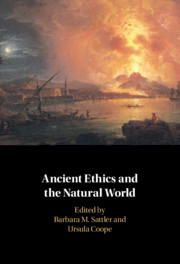Book contents
- Ancient Ethics and the Natural World
- Ancient Ethics and the Natural World
- Copyright page
- Dedication
- Contents
- Contributors
- Note on the Editors
- Introduction
- Part I Humans in Nature: Nature and Law, Humans and Natural Catastrophes
- Part II Humans as Godlike, Gods as Humanlike: Presocratics and Platonists
- Part III Emotions, Reason, and the Natural World (Aristotle)
- Chapter 6 Human and Animal Emotions in Aristotle
- Chapter 7 Reasonable and Unreasonable Affections and Human Nature
- Part IV Action and the Natural World (Aristotle)
- Part V The Naturalness of Goodness
- Bibliography
- Index Locorum
- General Index
Chapter 6 - Human and Animal Emotions in Aristotle
from Part III - Emotions, Reason, and the Natural World (Aristotle)
Published online by Cambridge University Press: 13 August 2021
- Ancient Ethics and the Natural World
- Ancient Ethics and the Natural World
- Copyright page
- Dedication
- Contents
- Contributors
- Note on the Editors
- Introduction
- Part I Humans in Nature: Nature and Law, Humans and Natural Catastrophes
- Part II Humans as Godlike, Gods as Humanlike: Presocratics and Platonists
- Part III Emotions, Reason, and the Natural World (Aristotle)
- Chapter 6 Human and Animal Emotions in Aristotle
- Chapter 7 Reasonable and Unreasonable Affections and Human Nature
- Part IV Action and the Natural World (Aristotle)
- Part V The Naturalness of Goodness
- Bibliography
- Index Locorum
- General Index
Summary
This chapter argues that, for Aristotle, human emotions are both different from, and also importantly continuous with, the emotions experienced by non-human animals. On the one hand, the repertoire of emotions experienced by human beings differs significantly from the repertoire experienced by non-human animals. The difference stems from the fact that only human beings have reason. Some human emotions (for example, shame) require the possession of reason and hence cannot be experienced by non-human animals. Other human emotions have counterparts in non-human animals, but they differ from these counterparts because, when functioning correctly, they are guided by reason. For instance, the disposition to feel fear is reason-governed in a human being but not in an animal. On the other hand, in spite of these striking differences between human and animal emotions, Dow argues that the emotions also reveal an important continuity between human beings and other animals: both human and animal emotions are fundamentally capacities to respond with pleasure or pain to situations that are apparently good or harmful to the subject. In this sense, emotion plays a similar role in the lives of humans and non-human animals.
- Type
- Chapter
- Information
- Ancient Ethics and the Natural World , pp. 109 - 124Publisher: Cambridge University PressPrint publication year: 2021



